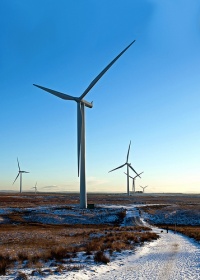Scotland sets tough energy targets
06 March 2012
The Scottish government will not oppose life extensions at the country's two operating nuclear power plants provided safety and security are assured, according to a newly released policy statement.
The draft Electricity Policy Generation Statement (EGPS) released by the Scottish government sets a number of targets and requirements, including a pledge to deliver "at least" 100% of gross electricity consumption from renewables by 2020, lowering final energy consumption by 12%, and demonstrating commercial-scale carbon capture and storage (CCS) by 2020, with full retrofitting across conventional power stations by 2025-2030. The policy aims to have a largely decarbonised generation mix by 2030.
 |
| The Scottish Parliament chamber |
The statement reiterates that the Scottish government remains "determined that nuclear energy will be phased out in Scotland over time," with no plans for new nuclear plants. However the statement recognises that the country's two operating nuclear plants - Hunterston B and Torness - make up a large proportion of the baseload energy supplied to the national grid, currently providing some 19% of Scottish generation. The government is emphatic that those plants still have an important role to play to help ensure security of supply over the next decade during the transition to renewables and clean thermal generation.
Hunterston is currently scheduled to close in 2016, with Torness following in 2023. Both plants comprise twin AGR units. The EPGS notes that the plants' operator, EDF Energy, plans to submit life extension applications for a minimum of five years beyond those dates for both plants. "Subject to the relevant safety case being made, the Scottish Government would not oppose operating life extensions at these sites," the document states. Before any life extension is granted, the UK's Office for Nuclear Regulation will need to be satisfied that high levels of safety and security could be maintained over the extended operating lifetime of the plant.
Renewables rising
 |
| Whitelee: currently Scotland and Europe's largest onshore windfarm (Image: Scottish Government/Russell Fallis) |
Although the confusing main target set by the Scottish government is to deliver "the equivalent of at least 100% of gross electricity consumption from renewables by 2020," officials were at pains to point out that this still does not mean that the country will be dependent on renewables. The renewables will be part of a "wider, balanced electricity mix" in which the government envisages a minimum of 2.5 GWe of thermal generation, progressively fitted with CCS technology as yet unproven on a commercial scale.
That such a target is achievable has been demonstrated in a model specially commissioned by the government, which shows that the 100% gross consumption from renewables by 2020 is "technically feasible." The model, prepared by consultants Sinclair Knight, looks at generation scenarios and power flows for a "plausible" generation mix, which sees on- and offshore wind generation providing over 50% of Scotland's output by 2020. As the model shows a nuclear contribution of only 9 TWh as compared to 2010's 16 TWh, the modellers did not appear to take into account a likely life extension to Hunterston, even one unopposed by government.
Scottish energy minister Fergus Ewing acknowledged that the government's 100% renewables target has been met with "doubt and scepticism," but said Scotland would rise to these challenges. "I want to debate, engage and co-operate with every knowledgeable, interested and concerned party to ensure we achieve our goals," he said.
Scotland's Green Party met the EGPS with dismay, criticising it as "using renewable energy as a 'gloss' to hide damaging plans for incinerators and nuclear power."
Although Scotland is part of the UK, the Edinburgh-based Scottish government is responsible for most day-to-day issues and on matters that are not explicitly reserved by the UK's Westminster parliament. These include planning issues affecting large-scale projects such as power stations.
The EPGS is open to public comment as part of a formal consultation process until 4 June 2012.
Researched and written
by World Nuclear News